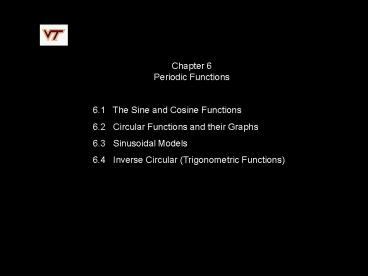Chapter 6 Periodic Functions PowerPoint PPT Presentation
1 / 14
Title: Chapter 6 Periodic Functions
1
Chapter 6Periodic Functions 6.1 The Sine and
Cosine Functions 6.2 Circular Functions and
their Graphs 6.3 Sinusoidal Models 6.4
Inverse Circular (Trigonometric Functions)
2
- Periodic Functions
- There is a whole class of natural behaviors whose
most striking characteristic is their cyclical
nature. - tides
- phases of the moon
- daily temperature
- sleep-wake cycles
- insect invasion
- seasonal sales
3
6.1 The Sine and Cosine Functions
KEY The unit circle with equation p2 q2 1
- Two ways to specify point on the circle
- p,q coordinates
- distance around circle
4
Using p, q coordinates
Suppose that a point P with coordinates (0.5, q)
is on the unit circle. Find the values of q.
Suppose that a point P with coordinates (p, 0) is
on the unit circle. Find the values of p.
5
- Using distance around circle
- starting point (1,0)
- wrap counter-clockwise
Suppose that a point P is located 2p units around
circle. Find the coordinates of P.
Suppose that a point P is located p units around
circle. Find the coordinates of P.
Suppose that a point P is located -p/2 units
around circle. Find the coordinates of P.
p ( 3.14) is a really NICE number when it comes
to measuring arcs
6
- Using distance around circle
- starting point (1,0)
- wrap counter-clockwise
directedarc -2p -3p/2 -p -p/2 0 p/2 p 3p/2 2p
terminalpoint
Let t represent the length of the arc traversed
counter-clockwise from (1,0) Find terminal point
corresponding to t 3p and t -7p/2 and t
2004p. Find terminal point corresponding to t 3
and t -5 and t 100.
7
Defining the Sine and Cosine Functions
The sine function, sin(t), is the second
coordinate (output), q, of the unit-circle point
(p,q) associated with the arc t (input).
The cosine function, cos(t), is the first
coordinate (output), p, of the unit-circle point
(p,q) associated with the arc t (input).
sine functionwrap t and identify (p,q)
t
q
cosine functionwrap t and identify (p,q)
p
t
8
Evaluating sine and cosine
tarc -2p -3p/2 -p -p/2 0 p/2 p 3p/2 2p
terminal point
sin(t)
cos(t)
CYU 6.3/293
9
6.2 Circular Functions and their GraphsBehavior
of Sine Function
As t increases from 0 to p/2, sin(t) ____________
from ___ to ___ (rapidly at first but then
slowly).
As t increases from p/2 to p, sin(t) ____________
from ___ to ___ (slowly at first but then
rapidly).
As t increases from p to 3p/2, sin(t)
____________ from ___ to ___ (rapidly at first
but then slowly).
As t increases from 3p/2 to 2p, sin(t)
____________ from ___ to ___ (slowly at first
but then rapidly).
As t increases from 2p to 5p/2, sin(t)
______________ from ___ to ___
10
Graph of f(t) sin(t)
local max? local min?
domain? range?
intercepts?
11
6.2 Circular Functions and their GraphsBehavior
of Cosine Function
As t increases from 0 to p/2, cos(t) ____________
from ___ to ___ (slowly at first but then
rapidly).
As t increases from p/2 to p, cos(t) ____________
from ___ to ___ (rapidly at first but then
slowly).
As t increases from p to 3p/2, cos(t)
____________ from ___ to ___ (slowly at first
but then rapidly).
As t increases from 3p/2 to 2p, sin(t)
____________ from ___ to ___ (rapidly at first
but then slowly).
As t increases from 2p to 5p/2, sin(t)
______________ from ___ to ___
12
Graph of f(t) cos(t)
domain? range?
intercepts?
local max? local min?
13
Comparison of Sine and Cosine Graphs
14
The connection between sine and cosine
We know sin(t) is the q coordinate. We know
cos(t) is the p coordinate. We know p2 q2 1.
Trig Identitysin(t)2 cos(t)2 1 sin2(t)
cos2(t) 1
CYU 6.5/298

